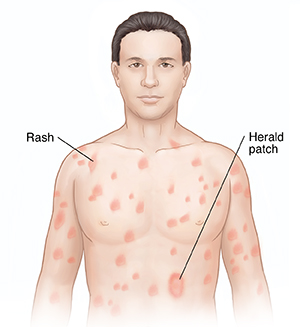Understanding Pityriasis Rosea
Pityriasis rosea is a type of skin rash. It starts with 1 large round or oval scaly patch called the herald patch, and then causes many more small patches. The rash most often appears on the chest, back, and belly. It can take 2 to 3 months to go away.
 |
| Pityriasis rosea on light skin. |
How to say it
piht-tah-RI-uh-sihs ROH-zee-ah
What causes pityriasis rosea?
The cause is not yet known but experts think it may be from a virus. The rash happens most often in people ages 10 to 35, and in pregnant people. If you're pregnant, make sure to tell your healthcare provider about your rash.
Some medicine reactions, and some forms of syphilis, may look a lot like pityriasis rosea. If your provider isn't sure, you may have blood tests done. Or you may need to test a sample of the rash (skin biopsy.)
Symptoms of pityriasis rosea
In some people, the rash shows up 1 to 2 weeks after symptoms such as headache, sore throat, upset stomach (nausea), stuffy nose, and fever. The rash often starts with 1 large scaly patch in the shape of a circle or oval. The patch may be pink or red if you have pale skin. It may be purple, brown, or gray if you have darker skin. It can be 1 to 2 inches wide or larger. It often appears on the chest or back. This is called a herald or mother patch.
Smaller scaly spots then show up in 1 to 2 weeks on the chest, back, belly, arms, and legs. It can also show up on the neck and face. The rash can form the shape of a Christmas tree on your back. The rash may itch, especially if your skin gets warmer during exercise or a hot shower. You may also feel tired and achy.
Treatment for pityriasis rosea
The rash should go away without treatment. But it can take 4 to 8 weeks or longer.
You can treat your itching with any of these:
-
Corticosteroid cream or ointment. You can apply this medicine to the rash 2 to 3 times a day, for 2 to 3 weeks.
-
Calamine lotion. This is a pink, watery lotion that can help stop itching.
-
Antihistamine. This medicine can help reduce itching. But it may also make you drowsy.
-
Other anti-itch lotion or cream. Ask your healthcare provider about other anti-itch lotion or cream that can help ease itching. They may prescribe a stronger medicine if over-the-counter medicine isn’t helping you.
If you have severe symptoms, your healthcare provider may treat you with:
-
Acyclovir. This is a type of anti-virus medicine. It may help the rash go away sooner in some people.
-
Ultraviolet light treatment. Exposing the skin to ultraviolet light in the first week can help lessen symptoms.
When to call your healthcare provider
Call your healthcare provider right away if you have any of these: